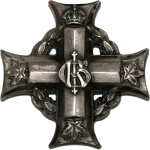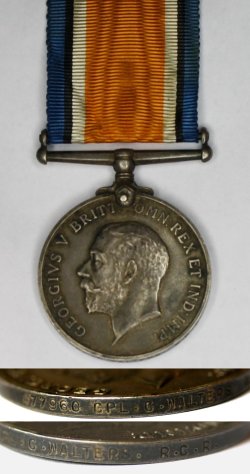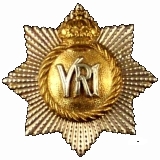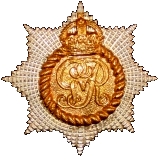

The First World War
Soldiers and Non-Commissioned Officers
of The Royal Canadian Regiment
477960 Cpl. Charles Fitzwalter
Which Walters' "Fitz"?
By: Captain Michael M. O'Leary, orginally published in the regimental journal of The Royal Canadian Regiment, PRO PATRIA 2006
It was just a single British War Medal (BWM), named to "477960 Corporal C. Walters, R.C.R." One of over 427,000 issued to Canadians in the Canadian Expeditionary Force (CEF), and one of about 4,000 issued to soldiers of The Royal Canadian Regiment. Separated from its companions, the 1914-15 Star and the Victory Medal, this particular BWM came into the collection of a member of the Regiment to join those of some of his fellow soldiers.

British War Medal awarded to 477960 Cpl. C. Walters (a.k.a. Fitzwalter). The location of his 1914-15 Star and Victory Medal are unknown.
But, what more can we learn about that soldier of the Great War?
While the Regiment was in Bermuda in 1914, the CEF was created in accordance with the direction and control of General Sir Sam Hughes, Minister of Militia. Part of the CEF structure included the allocation of blocks of service numbers to units as they were raised. This numbering system was put in place to eliminate the many overlapping sets of regimental numbers being assigned to soldiers by the first units. (The Soldiers of the First World War database at Library and Archives Canada lists 12 soldiers with the regimental number "1", and fifteen soldiers with "100".)
In August 1915, the troops of The Royal Canadian Regiment were back in Halifax after their year-long tour of garrisoning Bermuda. Reinforcements were absorbed and one significant step remained before the Regiment could sail to England. It was necessary that each soldier, NCO and officer sign attestation papers confirming their willingness to serve overseas with the CEF.
The Royal Canadian Regiment Depot in Halifax, where the units attested, was allocated the CEF regimental number blocks "477001 - 478000" and "478501 - 479000". Although the number block "480001 - 480200" was officially allocated to the 54th Battalion, CEF, the numbers 478001 to 478055, with a few exceptions, were also used by The RCR.
It is likely that the soldiers and NCOs of the battalion were paraded, sorted alphabetically and, starting on 16 August 1915 with Septimus John Abbott being assigned the regimental number 477001, attested for overseas service. As this process took some days, Frank Winton Zinck was assigned the number 478045 on the 24th of August. Some soldiers signed their papers later, so although the order of march through the Orderly Room was not strictly alphabetical, the initial assignment of regimental numbers to an alphabetized roll appears to have been done for the most part.
Towards the back of the line were two men, both of whom attested under the name of Charles Walters. These two soldiers were given the regimental numbers 477960 and 477961. Using these soldiers' names and regimental numbers as a start point, the Soldiers of the Great War database allows us to view their attestation papers on line.
477960 Charles Walters, formerly "7482", had previously served with the Regiment for six years from November 1907 to November 1913. He had completed his contracted service and was discharged at Halifax with a character recorded as "V. Good". 477960 Charles Walters re-enlisted in The RCR in February 1914, and was serving when the war started. He served with the Regiment in Bermuda in 1914-15. This Charles Walters was born in Bury, Lancashire, England on 16 June 1883, and claimed a trade of Painter.
477961 Charles (James) Walters, formerly "8082" attested for overseas service on August 23, 1915. He claimed no prior service with any military force. This Charles Walters was born in Birmingham, Warwickshire, England on 12 May 1891, and claimed a trade of Clerk.
And so the Regiment prepared for service in France; within the ranks are two Charles Walters, with regimental numbers only one digit apart. Both are expatriate Britons and both are approximately 5' 6" tall. Who might have expected that confusion over the identities of these two soldiers could ensue?
The first volume of the Regimental History has only one mention of a Charles Walters, and that is found in the Roll of Honour for the Great War. The entry reads:
Fitzwalter, Cpl. C.; 16 September 1916 (Served as Walters, Charles).
Charles Fitzpatrick, who served as Charles Walters of The Royal Canadian Regiment, was killed in action on 16 September 1916. The Regiment's War Diaryiii for that month includes a narrative annex describing the activities of the Regiment on 15, 16 and 17 September 1916, which states:
"The total casualties as far as can be ascertained amount to 1 Officer killed, 4 wounded and about 279 O.R. killed, wounded or missing."
Students of our regimental history will recognize these dates as part of the Battle Honour "Somme 1916", with those particular dates referring to:
THE ALLIED OFFENSIVE, 1916
Operations on the Somme. (1 July - 18 November, 1916)
(vi) Battle of Flers-Courcelette.15-22 September
The unanswered questions remains, "which Walters was Fitzwalter, which was awarded the medal which started our investigation, and who lies abroad in French soil?"
A search in the Soldiers of the First World War database at the Library and Archives Canada for "Charles Walters" provides the following, out of the 17 returned entries:
| Name | Date of Birth | Regimental Number |
| WALTERS, CHARLES | 16/06/1883 | 477960 |
| and | ||
| Name | Date of Birth | Regimental Number |
| WALTERS, CHARLES JAMES / FITZWALTER, CHARLES (AKA) | 15/05/1891 | 477961 |
From this information we find that our second man, 477961 Charles Walters was actually Charles Fitzwalter, who died overseas.
But, because not everything is so simple, digging a little further into available online resources leads us to the Canadian Virtual War Memorial which is found at the Veterans Affairs Canada website. An initial search on "Walters" with a year of death of 1916 gives no result pertinent to our intent. A search for "Fitzwalter" gives us this solitary record:
| Surname | Initial(s) | Given Name | Date of Death |
| FITZWALTER | C | CHARLES | Sep 16, 1916 |
The detailed record for Charles Fitzwalter provides the following information:
- In memory of Corporal CHARLES FITZWALTER who died on September 16, 1916.
- Military Service:
- Service Number: 477960
- Age: 36
- Force: Army
- Unit: Royal Canadian Regiment
- Additional Information: Son of Charles and Marian Fitzwalter, late of Buckley Wells, Bury, England.
The Soldiers of the First World War database tells us that the deceased Charles Walters, a.k.a. Fitzpatrick, is 477961 Walters. But the Canadian Virtual War Memorial, which uses data from the Commonwealth War Graves Commission records, tells us that it was 477960 Walters.
These contradictory records fail to resolve which Charles Walters was Charles Fitzpatrick. Does the British War Medal which started this search belong to the soldier who survived the war, or the soldier who died in France?
Returning to the Soldiers of the First World War database, we can find the required reference material to order the CEF personnel files for these soldiers.
| Names: | WALTERS, CHARLES |
| Regimental number: | 477960 |
| Reference: | RG 150, Accession 1992-93/166, Box 10061 - 53 |
| and | |
| Names: | WALTERS, CHARLES JAMES / FITZWALTER, CHARLES (AKA) |
| Regimental number: | 477961 |
| Reference: | RG 150, Accession 1992-93/166, Box 10062 - 4 |
For 477960 Walters we can order one package of documents, but for 477961 Walters we must order the package under the name Walters, and for confirmation, also the package under the name Fitzwalter. These documents come from the mass of paperwork retained by the Archives for the First World War. Over time, personnel records from Ottawa and Overseas were combined into singular files on each soldier, retaining (as a general rule) only those items related to proof of service, pay, pensionable service, medical care, and entitlements. Incomplete in many respects, perhaps, but far more than might have remained if the resources had ever been available to purge the collection thoroughly.
A review of the service records offers a few details:
- The service record for 477960 WALTERS, Charles, is annotated "alias Fitzwalter C."
- The service record for 477961 WALTERS, Charles, is annotated "True name is Fitzwalter, Chas."
- And the cover sheet of the service record for 477961 FITZWALTER, Charles, is annotated "see 477961 Walters, Chas." While the single page in the file states "477960 Cpl. WALTERS, Charles, R.C.R." is the true name of this soldier is FITZWALTER Charles under which his name has been cross referenced."
So, both of the "Walters" files claim to be Fitzwalter, while in two sheets of paper, the "Fitzwalter" file claims to be both soldiers. Examination of the files' contents, however, brings out a few more facts on each of these soldiers that helps to untangle this confusion.
477961 Charles Walters was employed as a clerk. On 4 November 1915 he was detached to General Headquarters, Canadian Section, 3rd Echelon at Rouen. He did not return to regimental duty until 31 October 1916. He was, therefore, not serving with the Regiment during the battles at the Somme during September, 1916. 477961 Walters finished the war with the Regiment holding the rank of Corporal and was discharged on 30 August 1919. He had achieved the rank of Sergeant in 1915, though that was forfeited in 1916 as a result of a court martial for drunkenness.
477960 Charles Walters served in France with The RCR until his death in September 1916. He was promoted to Corporal in June 1916 and was wounded that same month, being hospitalized for two weeks for gun shot wounds to his back and head. On 16 September 1916, along with many other soldiers of the Regiment, he was recorded as Killed in Action. In his file, the form detailing issue of medals, Memorial Cross and Plaque identifies his next of kin (father and brother) as Fitzwalter and notes "Enlisted under assumed name. Correct name: Fitzwalter."
Corporal Charles Fitzwalter (a.k.a., 477460 Charles Walters) has no known grave. His is one of the over 10,000 names engraved, including over 180 Royal Canadians, on the Vimy Memorial. The whereabouts of his other medals, Memorial Cross and Memorial Plaque are unknown.

Corporal Charles Walters' name as engraved on the outer wall of the Vimy Memorial.
Photo by Geoff Reeves.
Pro Patria
- The O'Leary Collection; Medals of The Royal Canadian Regiment.
- Researching Canadian Soldiers of the First World War
- Researching The Royal Canadian Regiment
- The RCR in the First World War
- Badges of The RCR
- The Senior Subaltern
- The Minute Book (blog)
- Rogue Papers
- Tactical Primers
- The Regimental Library
- Battle Honours
- Perpetuation of the CEF
- A Miscellany
- Quotes
- The Frontenac Times
- Site Map

![]() The RCR in the Great War
The RCR in the Great War
![]() War Diary
War Diary
![]() Battle Honours
Battle Honours
![]() Battle Bars and The RCR
Battle Bars and The RCR
![]() The RCR Battle Bar Ledger (pdf)
The RCR Battle Bar Ledger (pdf)
![]() Honours and Awards
Honours and Awards
![]() Roll of Honour
Roll of Honour
![]() Prisoners of War
Prisoners of War
![]() Cemetery List
Cemetery List
![]() Cemetery Map
Cemetery Map
![]() Courts Martial
Courts Martial
![]() Officers
Officers
![]() RSMs of The RCR (1914-1919)
RSMs of The RCR (1914-1919)
![]() NCOs and Soldiers
NCOs and Soldiers
![]() An Officer's Diary (1914-1918)
An Officer's Diary (1914-1918)
![]() Recollections of a Nonagenerian (R. England) (1916-1919)
Recollections of a Nonagenerian (R. England) (1916-1919)
![]() On to Bermuda (1914-15)
On to Bermuda (1914-15)
![]() England and France 1915-1916 (Hayes; 1931)
England and France 1915-1916 (Hayes; 1931)
![]() Overseas with The Royals (1915)
Overseas with The Royals (1915)
![]() Regimental History Pamphlet (1917)
Regimental History Pamphlet (1917)
![]() Amiens (1918)
Amiens (1918)
![]() Cambrai (1918)
Cambrai (1918)
![]() Monchy-le-Preux (1918)
Monchy-le-Preux (1918)
![]() Under-aged Soldiers in The RCR
Under-aged Soldiers in The RCR
![]() Not All Were Volunteers; The RCR and the Military Service Act
Not All Were Volunteers; The RCR and the Military Service Act
![]() Sentenced to Death by Court Martial
Sentenced to Death by Court Martial
![]() The 7th Trench Mortar Battery
The 7th Trench Mortar Battery
![]() A Regimental Goat
A Regimental Goat
![]() Regiment and Family, Bermuda 1914-15
Regiment and Family, Bermuda 1914-15
![]() "March the Guilty Bastard In"
"March the Guilty Bastard In"
![]() Surrendered as Stowaway
Surrendered as Stowaway
![]() Re-Visiting the Great War Roll of Honour for The RCR
Re-Visiting the Great War Roll of Honour for The RCR
![]() Canadian Corps Trench Standing Orders (1916)
Canadian Corps Trench Standing Orders (1916)


